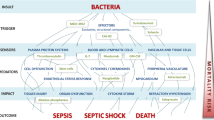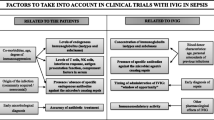Summary
Gram-negative bacteria release lipopolysaccharide (endotoxin) that causes sepsis and septic shock. Monoclonal antibodies against endotoxins have been proposed as a treatment of sepsis. One such antibody, nebacumab (HA-1A), was released onto the market in some European countries and its approval in the USA was recommended.
However, doubts raised by the lack of reproducible preclinical data, and by an independent reanalysis of the results of the first clinical trial, led to a further clinical trial. This second trial revealed an increase in mortality in nebacumabtreated patients. The trial was stopped and the drug withdrawn from the market.
To avoid such disappointments, the marketing of new biotechnology products should be based on critical scientific analysis, free from commercial pressures, of thorough, reproducible and consistent preclinical and clinical studies.
Similar content being viewed by others
References
Increase in National Hospital Discharge Survey rates for septicemia — United States, 1979–1987 [editorial]. Morb Mortal Wkly Rep 1990; 39: 31–4
Glauser MP, Zanetti G, Baumgartner JD, et al. Septic shock: pathogenesis. Lancet 1991; 338: 732–6
Baumgartner JD. Immunotherapy with antibodies to core LPS: a critical appraisal. Infect Dis Clin North Am 1991; 5: 915–27
Heumann D, Baumgartner JD, Jacot-Guillarmod H, et al. Antibodies to core lipopolysaccharide determinants: absence of cross-reactivity with heterologous lipopolysaccharides. J Infect Dis 1991; 163: 762–8
Baumgartner JD, Eggimann P, Glauser MP. Management of septic shock: new approaches. In: Remington JS, Swartz MN, editors. Current clinical topics in infectious diseases, vol. 12. Cambridge: Blackwell Scientific, 1992: 165–87
Ziegler EJ, McCutchan JA, Fierer J, et al. Treatment of Gram-negative bacteremia and shock with human antiserum to a mutant Escherichia coli. N Engl J Med 1982; 307: 1225–30
Baumgartner JD, Glauser MP, McCutchan JA, et al. Prevention of Gram-negative shock and death in surgical patients by prophylactic antibody to endotoxin core glycolipid. Lancet 1985; 2: 59–63
McCutchan JA, Wolf JL, Ziegler EJ, et al. Ineffectiveness of single-dose human antiserum to core glycolipid (E. coli J5) for prophylaxis of bacteremic, gram-negative infection in patients with prolonged neutropenia. Schweiz Med Wochenschr 1983; 113Suppl. 14: 40–5
J5 Study Group. Treatment of severe infectious purpura in children with human plasma from donors immunized with Escherichia coli J5: a prospective double-blind study. J Infect Dis 1992; 165: 695–701
Calandra T, Glauser MP, Schellekens J, et al. Treatment of Gram-negative septic shock with human IgG antibody to Escherichia coli J5: a prospective, double-blind, randomized study. J Infect Dis 1988; 158: 312–9
Intravenous Immunoglobulin Collaborative Study Group. Prophylactic intravenous administration of standard immune globulin as compared with core-lipopolysaccharide immune globulin in patients at high risk of postsurgical infection. N Engl J Med 1992; 327: 234–40
Baumgartner JD, Heumann D, Calandra T, et al. Antibodies to lipopolysaccharides after immunization of humans with the rough mutant Escherichia coli J5. J Infect Dis 1991; 163: 769–72
Teng NNH, Kaplan HS, Hebert JM. Protection against Gram-negative bacteremia and endotoxemia with human monoclonal IgM antibodies. Proc Natl Acad Sci USA 1985; 82: 1790–4
Young LS, Gascon R, Alam S, et al. Monoclonal antibodies for treatment of gram-negative infections. Rev Infect Dis 1989; 11Suppl. 7: S1564–S1571
Baumgartner JD, Heumann D, Glauser MP. The HA-1A monoclonal antibody for gram-negative sepsis [letter]. N Engl J Med 1991; 325: 281–2
Baumgartner JD, Heumann D, Gerain J, et al. Association between protective efficacy of anti-lipopolysaccharide (LPS) antibodies and suppression of LPS-induced tumor necrosis factor α and interleukin 6: comparison of O side chain-specific antibodies with core LPS antibodies. J Exp Med 1990; 171: 889–96
Ziegler EJ, Fisher CJ, Sprung CL, et al. Treatment of gram-negative bacteremia and septic shock with HA-1A human monoclonal antibody against endotoxin: a randomized, double-blind, placebo-controlled trial. N Engl J Med 1991; 324: 429–36
Warren HS, Danner RL, Munford RS. Anti-endotoxin monoclonal antibodies. N Engl J Med 1992; 326: 1153–7
Greenman RL, Schein RMH, Martin MA, et al. A controlled clinical trial of E5 murine monoclonal IgM antibody to endotoxin in the treatment of Gram-negative sepsis. JAMA 1991; 266: 1097–102
Wenzel R, Bone R, Fein A, et al. Results of a second double-blind, randomized, controlled trial of antiendotoxin antibody E5 in gram-negative sepsis [extended abstract]. In: Program and abstracts of the 31st Interscience Conference on Antimicrobial Agents and Chemotherapy; 1991 Sep 29–Oct 2; Chicago. Washington DC: American Society for Microbiology, 1991: 294
Wenzel RP. Antiendotoxin monoclonal antibodies — a second look. N Engl J Med 1992; 326: 1151–3
Winslow R. Effectiveness of new drug against septic infections is questioned by agency. Wall Street Journal 1992 Apr 16; B5
Fisher LM. Investors punish Centocor for more bad news. New York Times 1993 Jan 19; D1
Gazmuri RJ, Mecher C, Weil MH. The HA-1A monoclonal antibody for gram-negative sepsis [letter]. N Engl J Med 1991; 325: 279–80
Tanio CP, Feldman HI. The HA-1A monoclonal antibody for gram-negative sepsis [letter]. N Engl J Med 1991; 325: 280
Carlet J, Offenstadt G, Chastang C. The HA-1A monoclonal antibody for gram-negative sepsis [letter]. N Engl J Med 1991; 325: 280
Schmidt GA. The HA-1A monoclonal antibody for gram-negative sepsis [letter]. N Engl J Med 1991; 325: 280–1
Peled HB. The HA-1A monoclonal antibody for gram-negative sepsis [letter]. N Engl J Med 1991; 325: 281
Ziegler EJ, Fisher CJ, Sprung CL. The HA-1A monoclonal antibody for gram-negative sepsis [letter]. N Engl J Med 1991; 325: 282–3
Kweder SL, Schnur RA, Cooper EC. Inosine pranobex — is a single positive trial enough? N Engl J Med 1990; 322: 1807–9
Di Padova FE, Barclay R, Liehl E, et al. Widely cross-reactive anti-LPS core monoclonal antibodies have LPS neutralizing properties. Abstract CB404. J Cell Biochem 1992; Suppl. 16C–170
Saxen H, Vuopio-Varkila J, Luk J, et al. Detection of enterobacterial lipopolysaccharides and experimental endotoxemia by means of an immunolimulus assay using both serotype-specific and cross-reactive antibodies. J Infect Dis 1993; 168: 393–9
Piercey L. Star-crossed lovers — is biotech bad for science? Biopeople 1993; 4: 20–7
Tobias PS, Mathison JC, Ulevitch RJ. A family of lipopolysaccharide binding proteins involved in responses to gram-negative sepsis. J Biol Chem 1998; 263: 13479–81
Ooi CE, Weiss J, Doefler ME, et al. Endotoxin-neutralizing properties of the 25 kD N-terminal fragment and a newly isolated 30kD C-terminal fragment of the 55–60 kD bactericidal/permeability-increasing protein of human neutrophils. J Exp Med 1991; 174: 649–55
Marra MN, Snable JL, Scott RW, et al. Bactericidal/permeability-increasing protein: a naturally occurring lipopolysaccharide antagonist. Circ Shock 1991; 34–7
Heumann D, Gallay P, Betz-Corradin S, et al. Competition between bactericidal/permeability-increasing protein and lipopolysaccharide-binding protein for lipopolysaccharide binding to monocytes. J Infect Dis 1993; 167: 1351–7
Author information
Authors and Affiliations
Rights and permissions
About this article
Cite this article
Baumgartner, JD. Antiendotoxin Monoclonal Antibodies in Sepsis. Clin. Immunother. 1, 8–14 (1994). https://doi.org/10.1007/BF03258487
Published:
Issue Date:
DOI: https://doi.org/10.1007/BF03258487




